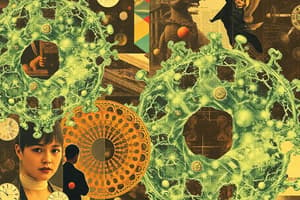Podcast
Questions and Answers
How do enzymes catalyze reactions?
How do enzymes catalyze reactions?
- By increasing the overall energy change (\$\Delta G\$) of the reaction.
- By providing energy to the reactants.
- By lowering the activation energy required for the reaction. (correct)
- By increasing the activation energy required for the reaction.
An enzyme's active site and allosteric site differ in that the active site is where the:
An enzyme's active site and allosteric site differ in that the active site is where the:
- noncompetitive inhibitor binds.
- substrate binds and reaction occurs. (correct)
- enzyme undergoes irreversible conformational change.
- enzyme is synthesized.
Which factor does NOT directly influence enzyme function?
Which factor does NOT directly influence enzyme function?
- Substrate concentration
- Temperature
- Atmospheric pressure (correct)
- pH
What is 'induced fit' in enzyme catalysis?
What is 'induced fit' in enzyme catalysis?
How does a competitive inhibitor decrease the rate of an enzyme reaction?
How does a competitive inhibitor decrease the rate of an enzyme reaction?
Activators increase enzyme activity by:
Activators increase enzyme activity by:
What is allosteric regulation of enzymes?
What is allosteric regulation of enzymes?
Which of the following catabolic pathways yields the most ATP per glucose molecule?
Which of the following catabolic pathways yields the most ATP per glucose molecule?
In cellular respiration, what molecule is reduced and what molecule is oxidized?
In cellular respiration, what molecule is reduced and what molecule is oxidized?
What is the primary role of oxygen in cellular respiration?
What is the primary role of oxygen in cellular respiration?
Which of the following correctly describes a redox reaction?
Which of the following correctly describes a redox reaction?
What is the oxidizing agent in the following reaction: $NAD^+ + 2e^- + 2H^+ \rightarrow NADH + H^+$?
What is the oxidizing agent in the following reaction: $NAD^+ + 2e^- + 2H^+ \rightarrow NADH + H^+$?
In which stage of aerobic respiration is ATP produced by substrate-level phosphorylation only?
In which stage of aerobic respiration is ATP produced by substrate-level phosphorylation only?
What is the net gain of ATP from glycolysis per glucose molecule?
What is the net gain of ATP from glycolysis per glucose molecule?
What is produced during pyruvate oxidation?
What is produced during pyruvate oxidation?
What is produced from one turn of the citric acid cycle?
What is produced from one turn of the citric acid cycle?
Chemiosmosis is best defined as:
Chemiosmosis is best defined as:
During cellular respiration, energy flows from:
During cellular respiration, energy flows from:
How is fermentation different from cellular respiration?
How is fermentation different from cellular respiration?
In alcohol fermentation, what is the final electron acceptor?
In alcohol fermentation, what is the final electron acceptor?
Flashcards
What are enzymes?
What are enzymes?
Biological molecules (usually proteins) that significantly speed up the rate of virtually all of the chemical reactions that take place within cells. They lower the activation energy required for a reaction to occur.
Enzyme Sites
Enzyme Sites
The active site is where the substrate binds and the catalytic action occurs. The allosteric site is a different location on the enzyme where a molecule can bind and influence the enzyme's activity.
Factors affecting Enzyme Function
Factors affecting Enzyme Function
Enzyme activity is affected by temperature, pH, enzyme concentration, substrate concentration, and the presence of any inhibitors or activators.
What is 'induced fit'?
What is 'induced fit'?
Signup and view all the flashcards
Competitive vs. Noncompetitive Inhibition
Competitive vs. Noncompetitive Inhibition
Signup and view all the flashcards
Activators and Inhibitors
Activators and Inhibitors
Signup and view all the flashcards
Allosteric Regulation
Allosteric Regulation
Signup and view all the flashcards
Catabolic Pathways
Catabolic Pathways
Signup and view all the flashcards
Cellular Respiration: Reactants & Products
Cellular Respiration: Reactants & Products
Signup and view all the flashcards
Fuel for Cellular Respiration
Fuel for Cellular Respiration
Signup and view all the flashcards
What is Redox Reaction?
What is Redox Reaction?
Signup and view all the flashcards
Oxidizing vs. Reducing Agent
Oxidizing vs. Reducing Agent
Signup and view all the flashcards
Electron Acceptors
Electron Acceptors
Signup and view all the flashcards
Stages of Aerobic Respiration
Stages of Aerobic Respiration
Signup and view all the flashcards
Glycolysis Summary
Glycolysis Summary
Signup and view all the flashcards
Pyruvate Oxidation
Pyruvate Oxidation
Signup and view all the flashcards
Citric Acid Cycle (Krebs Cycle)
Citric Acid Cycle (Krebs Cycle)
Signup and view all the flashcards
Substrate-Level Phosphorylation
Substrate-Level Phosphorylation
Signup and view all the flashcards
The Electron Transport Chain
The Electron Transport Chain
Signup and view all the flashcards
Chemiosmosis
Chemiosmosis
Signup and view all the flashcards
Study Notes
Enzymes
- Enzymes are proteins that act as catalysts to speed up biochemical reactions.
- Enzymes lower the activation energy of a reaction, making it easier to occur.
Enzyme-Catalyzed Reaction Diagram
- With an enzyme, the free energy diagram would show a lower activation energy peak compared to the uncatalyzed reaction.
Enzyme Active Sites
- Active site: Where the substrate binds and the reaction occurs.
- Allosteric site: Where molecules can bind to regulate enzyme activity (noncompetitive inhibitors or activators).
Factors Affecting Enzyme Function
- Temperature: Enzymes have an optimal temperature range; high temperatures can denature the enzyme
- pH: Enzymes have an optimal pH range; deviations can disrupt enzyme structure and function.
- Substrate Concentration: Increasing substrate concentration increases reaction rate until saturation.
- Inhibitors and Activators: These molecules can decrease or increase enzyme activity, respectively.
Induced Fit
- "Induced fit" refers to the conformational change an enzyme undergoes upon substrate binding, which results in tighter binding of the substrate to the active site and enhances the reaction.
Enzyme Inhibition
- Competitive inhibition: An inhibitor binds to the active site, blocking substrate binding.
- Noncompetitive/Allosteric inhibition: An inhibitor binds to an allosteric site, changing the enzyme's shape and reducing its activity.
Enzyme Regulation
- Activators bind to an enzyme and stabilize the active form, increasing its activity.
- Inhibitors bind to an enzyme and stabilize the inactive form, decreasing its activity.
Allosteric Regulation
- Allosteric regulation is when a regulatory molecule binds to an enzyme at one site (allosteric site) and affects the function of the enzyme at a different site (active site).
Catabolic Pathways
- Three pathways: Fermentation, Anaerobic respiration, and Aerobic/Cellular respiration.
- Fermentation: Partial degradation of sugars that occurs without oxygen.
- Anaerobic respiration: Similar to aerobic respiration but uses other substances than oxygen to accept electrons.
- Aerobic/Cellular respiration: Complete breakdown of organic molecules with oxygen, yielding more ATP.
Cellular Respiration
- Reactants: Glucose (C6H12O6) and Oxygen (O2).
- Products: Carbon Dioxide (CO2), Water (H2O), and ATP.
- Glucose is oxidized to CO2.
- Oxygen is reduced to Water.
Cellular Respiration Fuel
- Can be fueled by carbohydrates, fats, and proteins.
Redox Reactions
- Redox reaction: A chemical reaction involving the transfer of electrons between two species.
- Oxidation: The loss of electrons from a substance.
- Reduction: The gain of electrons to a substance.
Oxidizing and Reducing Agents
- Oxidizing agent: The substance that accepts electrons (is reduced).
- Reducing agent: The substance that donates electrons (is oxidized).
Electron Acceptors
- Aerobic/Cellular respiration: Oxygen (O2)
- Anaerobic respiration: Sulfate, nitrate and sulfur
Stages of Aerobic/Cellular Respiration
- Glycolysis
- Pyruvate Oxidation and Citric Acid Cycle (Krebs Cycle)
- Oxidative Phosphorylation (Electron Transport Chain and Chemiosmosis)
Glycolysis
- Input: Glucose, 2 ATP
- Output: 2 Pyruvate, 2 NADH, 4 ATP (net gain of 2 ATP)
- Products/Net Yield: 2 ATP (net), 2 NADH, 2 Pyruvate
- Location: Cytosol.
- ATP Production: Substrate-level phosphorylation.
Pyruvate Oxidation
- Input: 2 Pyruvate
- Output: 2 Acetyl CoA, 2 CO2, 2 NADH
- Products/Net Yield: 2 Acetyl CoA, 2 NADH, 2 CO2
- Location: Mitochondrial matrix.
- ATP Production: None directly.
Citric Acid Cycle (Krebs Cycle)
- Input: 2 Acetyl CoA
- Output: 4 CO2, 6 NADH, 2 FADH2, 2 ATP
- Products/Net Yield (per 1 Acetyl CoA): 1 ATP, 3 NADH, 1 FADH2, 2 CO2
- Products/Net Yield (per 2 Acetyl CoA): 2 ATP, 6 NADH, 2 FADH2, 4 CO2
- Location: Mitochondrial matrix.
- ATP Production: Substrate-level phosphorylation.
Oxidative Phosphorylation
- Consists of the Electron Transport Chain and Chemiosmosis.
Electron Transport Chain (ETC)
- Structure: A series of protein complexes embedded in the inner mitochondrial membrane.
- Function: Accepts electrons from NADH and FADH2, passes them down the chain, and uses the energy to pump protons (H+) across the inner mitochondrial membrane.
- Purpose: Creates a proton gradient that drives ATP synthesis via chemiosmosis.
Chemiosmosis
- Mechanism: H+ ions flow down their concentration gradient through ATP synthase, a protein complex in the inner mitochondrial membrane.
- Enzyme Involved: ATP synthase.
- End Result: The energy from the H+ gradient is used to phosphorylate ADP, producing ATP.
Energy Flow in Cellular Respiration
- Glucose → NADH/FADH2 → Electron Transport Chain → Proton-Motive Force → ATP
Anaerobic Respiration
- Differs from aerobic respiration by using a final electron acceptor other than oxygen (e.g., sulfate, nitrate).
Fermentation
- Similar to anaerobic respiration in that it doesn't use oxygen.
- Different from anaerobic respiration because it does not involve an electron transport chain.
Fermentation
- Consists of glycolysis plus reactions that regenerate NAD+, which can then be reused by glycolysis.
Types of Fermentation
- Alcohol Fermentation:
- Final electron acceptor: Acetaldehyde.
- Product: Ethanol and CO2.
- Lactic Acid Fermentation:
- Final electron acceptor: Pyruvate.
- Product: Lactate.
Regulation of Catabolism
- Cells regulate catabolism through feedback inhibition, where the end product of a metabolic pathway inhibits an enzyme early in the pathway.
Studying That Suits You
Use AI to generate personalized quizzes and flashcards to suit your learning preferences.





